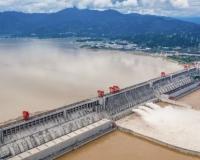- World
- Editorial | China’s Mega Dam on the Brahmaputra: A Brewing Headache for India!
Editorial | China’s Mega Dam on the Brahmaputra: A Brewing Headache for India!
China has embarked on constructing the world’s largest hydroelectric dam on the Brahmaputra River (Yarlung Tsangpo in Tibet), and while the project promises massive energy generation, it simultaneously raises alarming strategic, environmental, and geopolitical concerns—especially for India and Bangladesh. The ability to block water during dry seasons or release it without warning during floods gives China an upper hand over downstream nations. Such control could have catastrophic consequences for millions of people, especially farmers in India’s Northeast and in Bangladesh who rely heavily on the river.

Foundation Laid, Concerns Ignored
Just last week, Chinese Premier Li Qiang presided over the groundbreaking ceremony of this ambitious project. But this is no sudden development. China has long hinted at its plans to build a mega dam at the great bend of the Yarlung Tsangpo, near the disputed Arunachal Pradesh border. India had officially objected to the project six months ago, raising concerns through its Ministry of External Affairs in January. The Indian government cautioned that a dam on a transboundary river like the Brahmaputra could negatively impact downstream states, urging Beijing to ensure that lower riparian nations would not be harmed.
China, however, dismissed these objections, insisting that the dam would have no adverse downstream effects. Yet, given China's past behavior and a general lack of transparency, India remains unconvinced. The region lies on a highly seismically active zone, a tectonic fault line prone to earthquakes. The ecological fragility of this terrain makes dam construction here not only risky but potentially disastrous in the long run.
The Engineering Challenge and Strategic Leverage
Brahmaputra, before entering India, plunges nearly 25,000 feet through the world's deepest gorge. Building a dam here is not only a technological marvel but also a strategic move. China claims the project is the outcome of decades of research, designed with environmental safeguards. Yet, given the dam’s massive scale—rumored to have a power generation capacity of over 100,000 MW the implications extend far beyond electricity.
The dam is part of China’s larger goal to transition to green energy, reduce reliance on coal, and achieve carbon neutrality by 2060. But in parallel, it gives China geopolitical leverage over South Asia’s water resources. The Yarlung Tsangpo becomes the Siang and then Brahmaputra in India, and eventually turns into the Jamuna in Bangladesh. Any manipulation upstream will inevitably affect water flow, sediment balance, agriculture, and ecology in these countries.
An Earth-Sized Impact
The environmental concerns are not just local they may be planetary. Studies by NASA and other global scientific institutions suggest that massive infrastructure projects like dams can impact Earth’s rotation and axis stability. The Three Gorges Dam, for instance once the world’s largest hydroelectric dam (also in China) has been linked to a 0.06 microsecond slowing of Earth’s rotation, due to redistribution of water mass.
Scientists fear that the new Brahmaputra mega-dam could have similar or greater effects. With an estimated storage capacity of over 10.6 trillion gallons (40 cubic kilometers), the dam could alter Earth's mass distribution, even minutely. NASA experts like Dr. Benjamin Fong Chao have long cautioned that human activities mining, deforestation, mega-constructions collectively affect Earth’s motion, climate, and long-term stability.
China’s Ambition, South Asia’s Concern
The Motuo Hydropower Project, as it is officially known, is expected to cost around 1.2 trillion yuan (~$167 billion or ₹1.44 lakh crore). Once completed, it will surpass the Three Gorges Dam and become the largest hydroelectric facility in the world, producing three times the energy of its predecessor.
This dam will consist of five cascade power stations, allowing controlled and continuous electricity generation. It aligns with China's vision of replacing fossil fuels with renewable energy but it also gives Beijing a tight grip on one of Asia’s most vital water sources.
The 2020 report by the Lowy Institute (Australia) had already warned that China’s control over rivers originating from the Tibetan Plateau gives it significant leverage over India's economy. India’s water security becomes vulnerable, not just due to military tensions on the LAC but also because of this hydrological dependence.
Bangladesh, too, has expressed concern over the implications of reduced water flow in the Jamuna River, particularly during dry seasons. With agriculture being a key economic pillar in both countries, the possibility of water scarcity or flooding becomes a matter of national security.
Hydropolitics: A New Front
While India and China have signed an agreement (2006) on sharing hydrological data during monsoon seasons, China is not legally bound to share real-time or emergency-level information. In the past, delays or refusal in data sharing during floods have worsened disaster responses in Assam and Arunachal Pradesh.
Moreover, China’s growing dam infrastructure not only helps its own energy goals but weaponizes water—turning rivers into instruments of coercion. At a time when water wars are predicted to define global conflicts, this dam represents an unsettling new reality.
Between Engineering and Empire
While China paints the Motuo Dam as a technological and ecological milestone, for India and Bangladesh, it represents a ticking time bomb. The fear is not just ecological or geological it's existential.
Be it deliberate water blockage, sudden flood-like releases, or long-term erosion of riverine ecosystems, the risks are multifaceted. Trust in Beijing remains low, and without international transparency mechanisms or water-sharing treaties, India’s diplomatic protest stands on weak ground.
This dam is more than a power project it is a statement of intent, and a warning to downstream nations. The dragon has placed its foot firmly on one of South Asia’s most sacred rivers. Whether this will lead to regional instability or wake the world to new hydro-strategic realities is yet to be seen.
000









